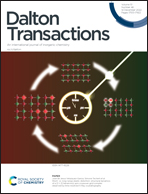Remodelling the surface of thioredoxin from Escherichia coli by grafting an iron-binding site from the CyaY protein family†
Abstract
In this work, we have designed and generated a Fe(III)-binding protein with thiol oxidoreductase activity. The consensus iron-binding motif EExxED from the frataxin protein family was grafted on a model peptide and on the surface of thioredoxin (TRX) from E. coli. We investigated metal interactions with a family of peptides containing the motif EExxED or altered versions obtained by removing negatively charged residues: EExxEx, xExxED, and xExxEx. The interaction of the metal ion with the peptides was studied by circular dichroism, and our results indicated that the motif EExxED retained its functional properties and also that this motif is able to bind Ga(III) and Al(III). The interaction of the grafted TRX with iron(III) was investigated by NMR, showing that the motif was functional in the context of the protein structure, and also the binding of two equivalents of Fe(III) per TRX molecule was stable in a non-chelating neutral buffer. Protein conformation, stability, and enzymatic activity were studied by applying experimental and computational approaches. Interestingly, the thiol oxidoreductase activity was modulated by interaction with Ga(III), a Fe(III) mimetic ion. Furthermore, the design of functional proteins with both functions, oxidoreductase activity and metal-ion binding ability, should consider the reorganisation of the electrostatic network. Similarly, studying the crosstalk and electrostatic balance among different metal-binding sites may be critical.



 Please wait while we load your content...
Please wait while we load your content...